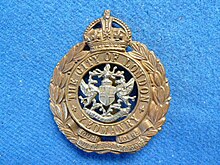City of London Yeomanry (Rough Riders)
| The City of London Yeomanry (Rough Riders) | |
|---|---|

COLY Cap Badge
|
|
| Active | 23 July 1901 – 1 May 1961 |
| Country |
|
| Branch |
|
| Type | Yeomanry |
| Role |
Cavalry (1901) Field artillery (1920) Light Anti-Aircraft artillery (1938) Armour (1947) Infantry (1956) Signals (1969) |
| Size | Regiment |
| Garrison/HQ | The Guildhall, Finsbury Square |
| Nickname(s) | Rough Riders |
| Patron | Her Majesty Queen Elizabeth The Queen Mother (1952) |
| Motto(s) | Domine Dirige Nos (Lord, direct us) |
| Mascot(s) | The Lobster |
| Engagements | |
| Commanders | |
| Notable commanders |
R.B. Colvin; Frederick Maitland, 14th Earl of Lauderdale Goland Clarke |
The City of London Yeomanry (Rough Riders) was a yeomanry regiment of the British Territorial Army, formed in 1901 and amalgamated in 1961.
The City of London Yeomanry had originally been formed in 1900 as the 20th Battalion, Imperial Yeomanry, and designated for service in the Second Boer War. The battalion's adopted nickname of the "Rough Riders" was taken from the US cavalry regiment that fought in the Spanish–American War. An additional battalion, the 22nd Rough Riders, was then formed in 1901, when the 20th Battalion was disbanded and the new regiment was formed from Boer War veterans and named the 1st County of London (Rough Riders) Imperial Yeomanry. This regiment was retitled The City of London (Rough Riders) Imperial Yeomanry in April 1902, with its headquarters at the Guildhall. The HQ later transferred to Finsbury Square, and the regiment, upon joining the newly established Territorial Force in 1908, was again retitled as the 1st City of London Yeomanry (Rough Riders).
In accordance with the Territorial and Reserve Forces Act 1907 (7 Edw. 7, c.9) which brought the Territorial Force into being, the TF was intended to be a home defence force for service during wartime and members could not be compelled to serve outside the country. However, on the outbreak of war on 4 August 1914, many members volunteered for Imperial Service. Therefore, TF units were split in August and September 1914 into 1st Line (liable for overseas service) and 2nd Line (home service for those unable or unwilling to serve overseas) units. Later, a 3rd Line was formed to act as a reserve, providing trained replacements for the 1st and 2nd Line regiments.
...
Wikipedia
